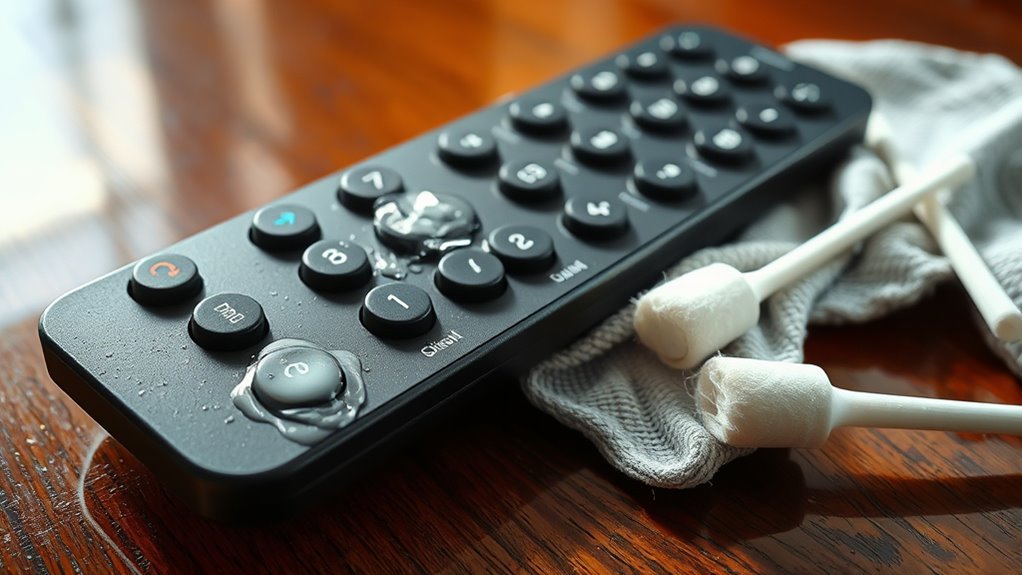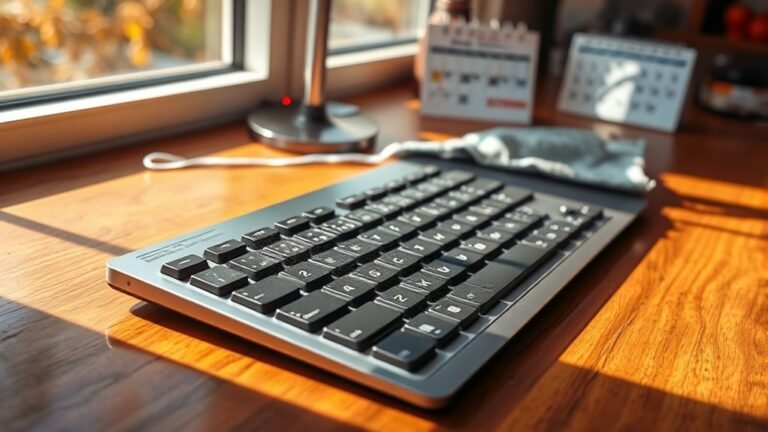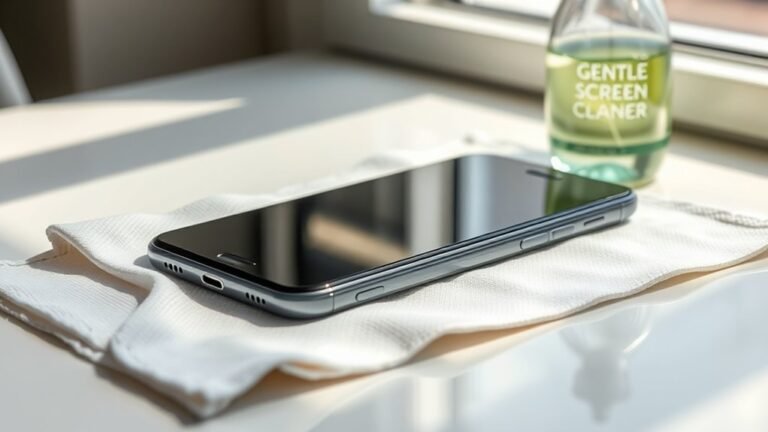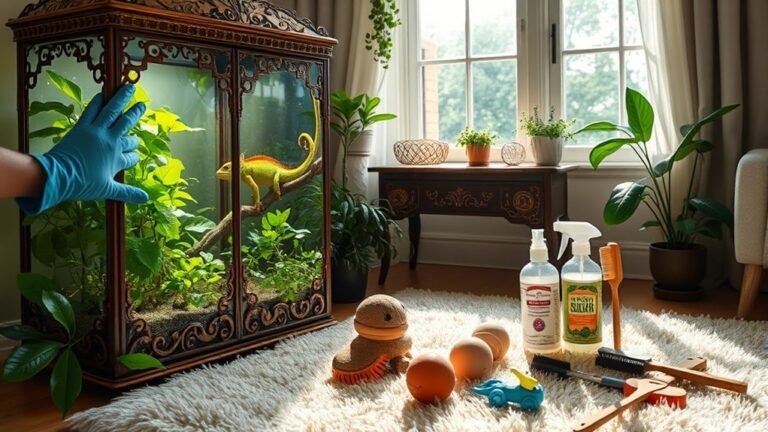Cleaning Mistakes That Damage Your Remote
You’re likely damaging your remote by using too much water or harsh solvents, which cause internal corrosion and degrade plastic parts. Submerging it or spraying cleaners directly risks liquid seeping into circuitry and batteries, leading to short circuits. Abrasive scrubbing can scratch surfaces and impair buttons, while neglecting battery compartment cleaning fosters corrosion. Using paper towels leaves residues that attract grime. Proper techniques prevent malfunction and extend lifespan—explore further to safeguard your device effectively.
Using Excessive Water or Liquid Cleaners

One common mistake people make when cleaning their remote controls is using excessive water or liquid cleaners. When you apply too much moisture, you increase liquid absorption risks, which can lead to internal circuit damage. Remote controls are not designed to withstand prolonged exposure to liquids, and excessive moisture concerns arise because water can seep beneath buttons and into sensitive electronic components. To protect your remote’s functionality, avoid spraying cleaners directly onto the device. Instead, lightly dampen a microfiber cloth to minimize liquid intrusion. This approach lets you clean effectively without compromising your remote’s internal mechanisms. By controlling the amount of moisture, you maintain operational freedom and prevent costly repairs or replacements caused by liquid damage.
Applying Harsh Chemicals or Solvents
You shouldn’t use harsh chemicals or solvents on your remote, as they can trigger chemical reactions that degrade plastic surfaces. These substances might also seep inside, causing corrosion to internal electronic components. Protecting your device means choosing gentle, electronics-safe cleaning agents instead.
Chemical Reactions on Plastics
Although harsh chemicals might seem effective for cleaning, they can cause damaging chemical reactions on the plastic surfaces of your remote. When you apply solvents without considering chemical compatibility, you risk accelerating plastic degradation. This can lead to discoloration, brittleness, or even cracks on the casing. To maintain the integrity of your remote, avoid chemicals that interact negatively with plastics.
Keep in mind these points:
- Some solvents dissolve plasticizers, weakening structural integrity
- Acetone and alcohol can cause surface crazing or cloudiness
- Prolonged exposure accelerates polymer breakdown
- Incompatible chemicals may strip protective coatings
- Testing on a hidden area helps guarantee safety
Corrosion of Internal Components
When harsh chemicals or solvents seep into your remote’s internal components, they can initiate corrosion that impairs functionality. This corrosion results from chemical reactions between the solvent residues and the metal contacts or circuitry inside. To guarantee effective corrosion prevention, avoid applying liquid cleaners directly on the remote; instead, use minimally dampened cloths. Maintaining internal protection is essential since corrosive damage is often irreversible and leads to malfunction. You should also avoid aggressive solvents like acetone or alcohol-based cleaners that can degrade protective coatings on circuit boards. Prioritize using mild, electronics-safe cleaning agents and confirm your remote is fully dry before use. By carefully controlling the cleaning process, you preserve the internal components’ integrity, extending your device’s operational lifespan while maintaining your freedom from frequent replacements.
Submerging the Remote in Cleaning Solutions
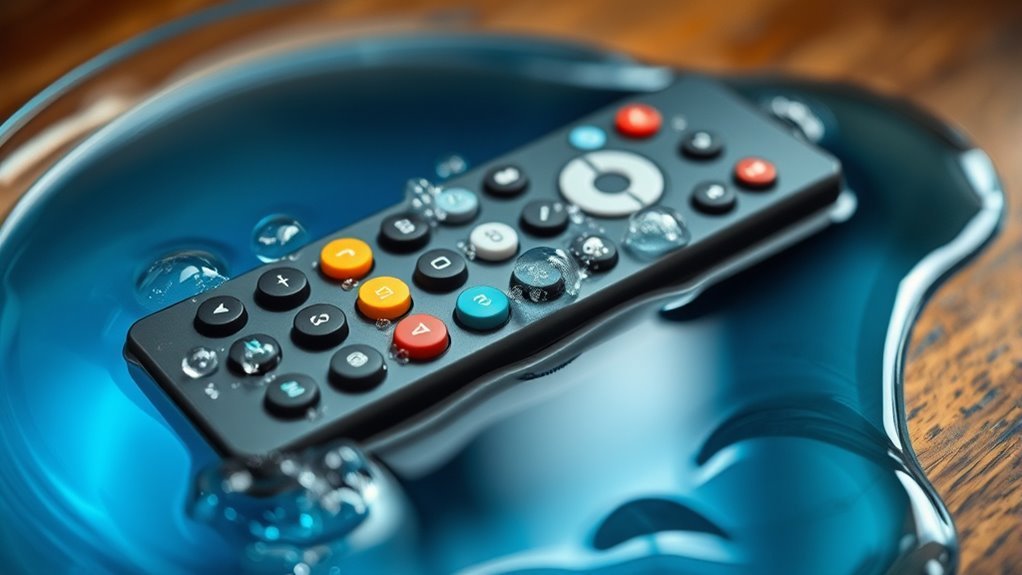
Since remote controls contain sensitive electronic components, submerging them in cleaning solutions can cause irreversible damage. The submerging risks include short circuits, corrosion, and permanent failure of the device. When you immerse a remote, liquid can penetrate seals and reach the circuit board, disrupting its function. To maintain your freedom to use your device without interruptions, avoid this cleaning mistake.
Instead, consider these safer practices:
- Use a lightly dampened cloth with isopropyl alcohol.
- Avoid excessive liquid exposure near battery compartments.
- Employ cotton swabs for tight spaces without soaking.
- Confirm the remote is powered off before cleaning.
- Allow the remote to dry completely before use.
Using Abrasive Materials for Scrubbing
One common mistake people make is using abrasive materials to scrub their remote controls, which can cause surface damage and impair button functionality. Abrasive materials like rough sponges, steel wool, or harsh brushes can scratch the plastic casing and wear down printed labels on buttons, reducing their legibility. These scrubbing techniques may also force dirt deeper into crevices, complicating cleaning instead of improving it. Instead, you should opt for soft microfiber cloths or gentle foam swabs to clean the remote’s surface. Use minimal pressure and avoid circular scrubbing motions that might accelerate wear. By selecting appropriate tools and scrubbing techniques, you preserve your remote’s integrity and guarantee it remains fully operational without sacrificing its aesthetic or tactile qualities.
Ignoring Battery Compartment Cleaning
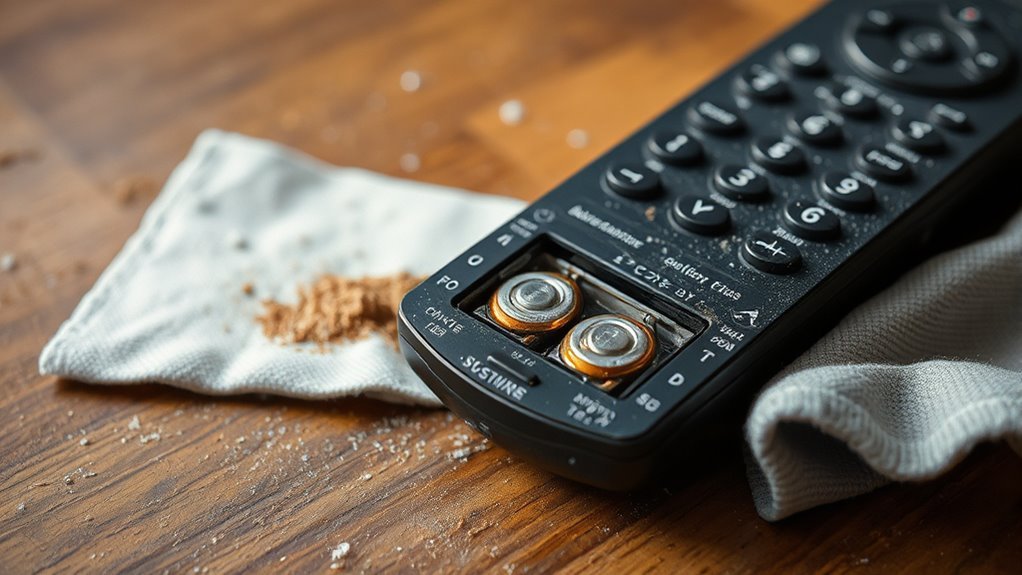
Neglecting the battery compartment is a frequent oversight that can lead to corrosion, poor electrical contact, and remote malfunction. Proper battery maintenance includes maintaining compartment hygiene to guarantee your remote functions reliably. When you skip cleaning, residue and moisture can accumulate, causing battery leakage or connectivity issues.
Neglecting battery compartment care causes corrosion and connectivity issues, risking remote malfunction.
To maintain peak performance:
- Regularly inspect the battery compartment for corrosion or residue.
- Use a dry cloth or cotton swab to clean terminals and crevices.
- Remove batteries if the remote won’t be used for extended periods.
- Replace batteries promptly at signs of wear or leakage.
- Avoid mixing old and new batteries to prevent compartment damage.
Spraying Cleaners Directly on the Remote
You shouldn’t spray cleaners directly on your remote, as moisture can seep inside and cause internal damage. Residue from these cleaners may build up around buttons, leading to sticky or unresponsive controls. Protect your device by applying cleaning solutions to a cloth instead of spraying it straight onto the remote.
Moisture Damage Risks
Spraying cleaners directly onto your remote introduces moisture that can seep into the internal circuitry, causing short circuits and corrosion. This moisture intrusion compromises the electronic components, leading to malfunction or permanent damage. Effective moisture control is essential not only during cleaning but also in remote storage to prevent prolonged exposure to humidity.
To protect your remote from moisture damage:
- Avoid spraying liquids directly; apply cleaner to a cloth first
- Use minimal liquid amounts to prevent seepage
- Store remotes in dry, temperature-controlled environments
- Regularly inspect for signs of moisture or corrosion
- Utilize silica gel packs or desiccants in storage areas
Cleaner Residue Buildup
While moisture is a primary concern when cleaning your remote, the buildup of cleaner residue from improper application can also impair its functionality. Spraying cleaning solutions directly onto the remote often causes excess liquid to seep into crevices, leaving behind a sticky film as it dries. This residue can attract dust and grime, interfering with button responsiveness and sensor accuracy. To maintain ideal remote care, always apply cleaning solutions to a microfiber cloth first, then gently wipe the surface. Avoid saturating the device to prevent residue accumulation. By controlling the amount and method of application, you preserve the remote’s internal components and surface integrity. Proper technique guarantees your remote stays free of abrasive buildup, extending its lifespan and maintaining smooth operation without sacrificing your freedom to clean effectively.
Button Malfunction Causes
A common cause of button malfunction in remotes stems from applying cleaning sprays directly onto the device. When liquid seeps inside, it can disrupt the electrical contacts beneath the buttons, leading to button responsiveness issues. Over time, this moisture exposure can corrode circuits, requiring costly remote control repairs or complete replacement.
Avoid these pitfalls to protect your remote:
- Liquid infiltration damaging internal circuits
- Sticky residue causing buttons to stick or fail
- Short-circuiting from excessive moisture
- Degradation of conductive pads under buttons
- Accelerated wear leading to unresponsive controls
To maintain ideal function and freedom in device use, always spray cleaners onto a cloth first, then wipe your remote gently. This prevents moisture damage and extends your remote’s lifespan without compromising button responsiveness.
Neglecting to Remove Batteries Before Cleaning
Before you start cleaning your remote, you should always remove the batteries to prevent potential damage. Neglecting this step risks short-circuiting or corrosion, compromising both battery safety and remote hygiene. Batteries can leak harmful chemicals if exposed to moisture during cleaning, which may corrode internal components and shorten your remote’s lifespan. Additionally, moisture trapped inside the battery compartment can cause electrical failures or malfunctions. Removing batteries guarantees you can clean the remote thoroughly without risking damage to electronic circuits or risking personal safety. Prioritize this safety measure to maintain your remote’s functionality and longevity, while confidently practicing effective remote hygiene. This simple precaution empowers you to clean freely and responsibly, avoiding costly repairs or replacements stemming from avoidable battery-related incidents.
Using Compressed Air Incorrectly
How should you use compressed air when cleaning your remote to avoid damage? Proper compressed air usage is essential to maintain your remote’s integrity. If you’re too close, the strong blast can force debris deeper or damage delicate internal components. Maintaining proper air distance—typically 6 to 8 inches—ensures debris is gently dislodged without harm.
Use compressed air from 6 to 8 inches away to safely dislodge debris without damaging your remote.
Keep these tips in mind:
- Always hold the can upright to prevent liquid propellant release.
- Use short, controlled bursts instead of continuous spraying.
- Avoid inserting the nozzle into crevices; keep a safe air distance.
- Test on less sensitive areas first to gauge pressure effect.
- Store compressed air cans in a cool, dry place to maintain pressure consistency.
Overlooking the Importance of Regular Cleaning
You might not realize that skipping regular cleaning allows dirt and debris to build up inside your remote, which can interfere with button responsiveness. Neglecting routine maintenance increases the risk of grime accumulation that can cause electrical contacts to fail. Consistent cleaning is essential to maintain peak remote functionality and extend its lifespan.
Neglecting Routine Maintenance
Although it might seem minor, neglecting routine maintenance can greatly shorten your remote’s lifespan. Skipping regular cleaning allows grime and debris to infiltrate internal components, reducing responsiveness and increasing the risk of malfunction. To keep your remote functioning smoothly, adhere to these essential maintenance tips:
- Perform routine cleaning at least once a month.
- Use a soft, lint-free cloth dampened with isopropyl alcohol.
- Avoid excess moisture near battery compartments.
- Remove batteries during extended periods of disuse.
- Inspect buttons for sticky residue and clean promptly.
Dirt Accumulation Risks
Routine maintenance plays a significant role in preventing dirt buildup, but overlooking regular cleaning can still lead to substantial dirt accumulation inside your remote. Over time, dust, skin oils, and debris infiltrate crevices, impairing internal components. To maintain peak performance, you must adopt effective dirt prevention techniques, such as using compressed air and gentle cleaning agents. Adjusting your remote cleaning frequency based on usage and environment is essential—neglecting this increases contamination risk. Regular inspection and cleaning help you avoid entrenched grime that’s harder to remove and can cause irreversible damage. Keeping a consistent cleaning schedule not only preserves the remote’s longevity but also guarantees you retain full control freedom without interruptions caused by dirt-related issues. Don’t underestimate the importance of timely dirt prevention.
Impact on Functionality
When regular cleaning is overlooked, the functionality of your remote control can degrade considerably. Dirt, oils, and debris interfere with the internal contacts, reducing the device’s functional performance and risking unresponsiveness. Neglecting maintenance shortens operational longevity, forcing premature replacements.
To maintain peak performance and extend your remote’s lifespan, pay attention to these factors:
- Accumulation of grime causing button sticking or failure
- Obstruction of infrared sensors diminishing signal transmission
- Corrosion on battery contacts due to moisture and dirt
- Dust buildup impairing circuit board connections
- Increased risk of internal component damage from contaminants
Using Paper Towels or Tissues That Leave Residue
Many common paper towels and tissues contain fibers or coatings that leave microscopic residues on your remote’s surface. These residue effects can accumulate over time, attracting dust and grime, which impair button responsiveness and may cause sensor interference. Using such materials compromises the longevity and reliability of your remote, limiting your freedom to enjoy uninterrupted control. To avoid these issues, opt for alternative materials specifically designed for electronics cleaning, such as microfiber cloths. These cloths effectively capture dirt without leaving residues or scratching surfaces. Additionally, using isopropyl alcohol diluted with water on a microfiber cloth can enhance cleaning efficiency without damaging internal components. By choosing the right materials, you maintain your remote’s peak functionality and extend its lifespan, empowering you with consistent, hassle-free device operation.
Frequently Asked Questions
How Often Should I Replace My Remote Control Batteries?
Imagine your remote control’s batteries like a marathon runner—you wouldn’t expect them to sprint forever without rest. Typically, battery longevity lasts between 6 to 12 months, depending on usage and remote maintenance. To guarantee uninterrupted freedom in controlling your devices, replace batteries when you notice sluggish response or dim signals. Regularly checking and swapping batteries prevents sudden power loss, keeping your remote running smoothly and your control uninterrupted.
Can a Dirty Remote Affect My Tv’S Performance?
Yes, a dirty remote can cause remote signal interference, reducing your TV’s responsiveness. Dust, grime, or cleaning product residues on the remote’s sensor or buttons can block or weaken the infrared signals it sends. To maintain peak performance, regularly clean your remote with a soft, lint-free cloth and avoid harsh chemicals that leave residues. Keeping the remote clean guarantees clear signal transmission, giving you the freedom to control your TV without frustration.
What Is the Best Way to Disinfect a Remote Control?
When disinfecting a remote control, you’ll want to use effective disinfecting methods that won’t harm the device. Start by removing batteries, then use a soft cloth lightly dampened with isopropyl alcohol (70% concentration) or a mild cleaning solution designed for electronics. Avoid spraying liquids directly to prevent damage. Gently wipe all surfaces, focusing on buttons and crevices. Let it dry completely before reinserting batteries. This method guarantees thorough disinfection without compromising functionality.
Are Silicone Remote Covers Effective for Protection?
Silicone remote covers offer excellent protection due to silicone benefits like shock absorption and water resistance. By fitting snugly over your remote, they shield it from dust, spills, and minor drops, enhancing remote longevity. These covers are flexible, durable, and easy to clean, allowing you to maintain your device without hassle. If you want to extend your remote’s life while enjoying freedom from constant worry, silicone covers are a smart, practical choice.
Can Extreme Temperatures Damage My Remote Control?
Extreme cold freezes components; extreme heat warps circuitry. Both temperature effects can severely compromise your remote’s functionality and reduce remote longevity. When exposed to harsh conditions, internal batteries may leak, buttons may stick, and plastic casings can crack. To preserve your remote’s freedom and performance, keep it within recommended temperature ranges, avoid direct sunlight, and store it in stable environments. This careful handling guarantees your remote lasts longer and works reliably.
